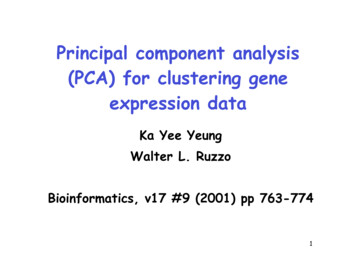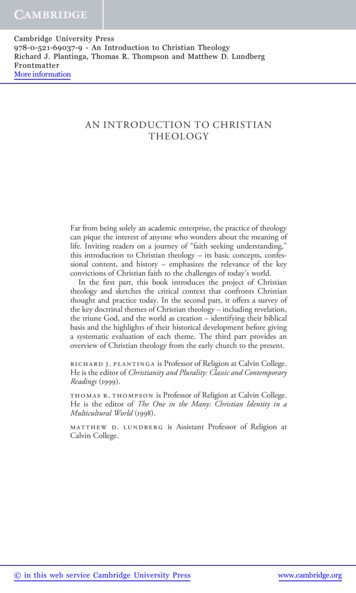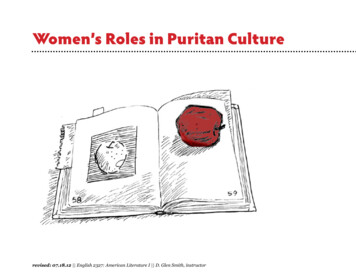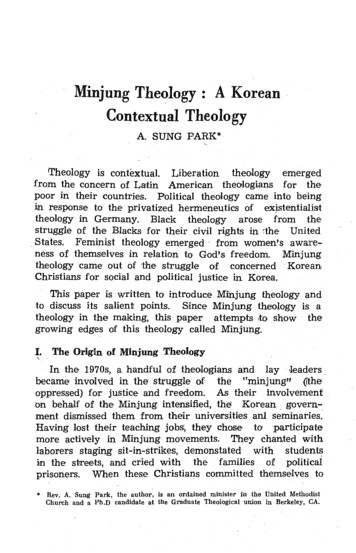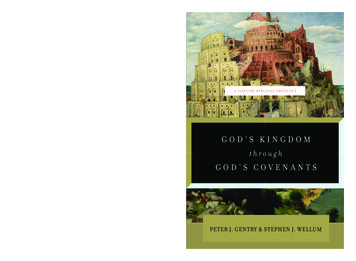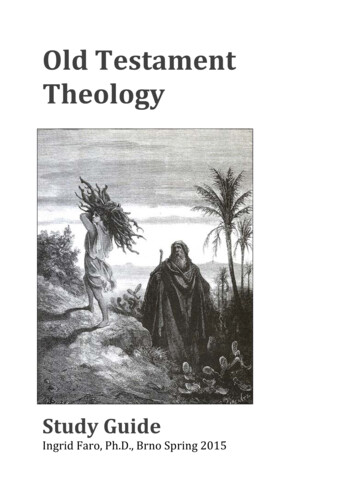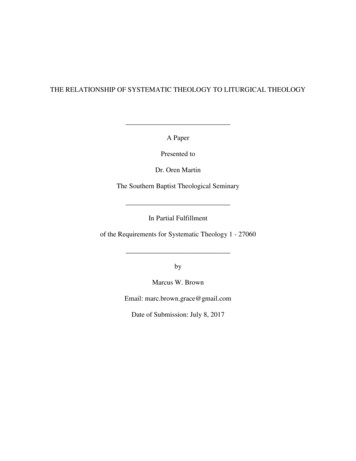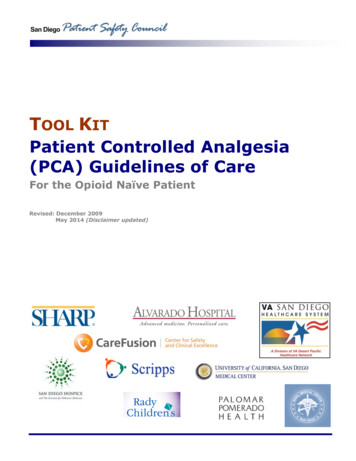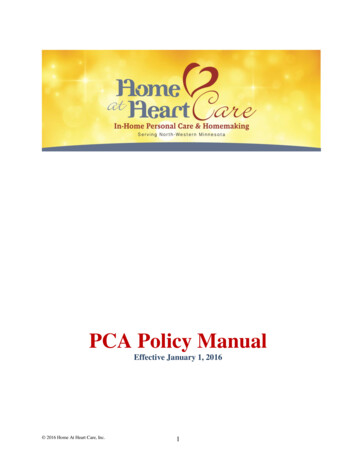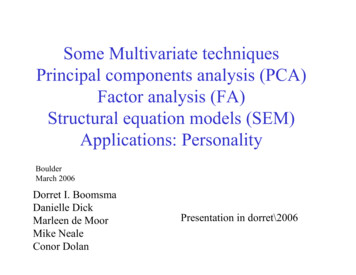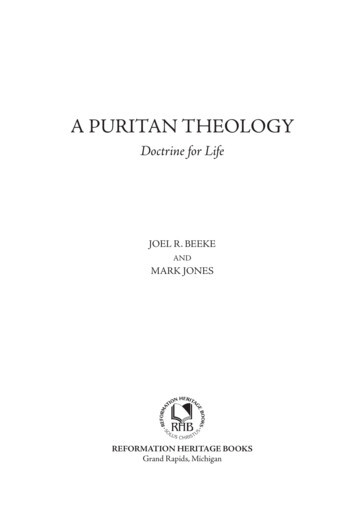
Transcription
A PURITAN THEOLOGYDoctrine for LifeJOEL R. BEEKEANDMARK JONESREFORMATION HERITAGE BOOKSGrand Rapids, Michigan
ContentsIntroduction 9Prolegomena1. The Puritans on Natural and Supernatural Theology2. Puritan Hermeneutics and Exegesis3. The Learned Doctor William Ames and The Marrow of TheologyTheology Proper4. Stephen Charnock on the Attributes of God5. The Puritans on the Trinity6. John Owen on Communion with the Triune God7. William Perkins on Predestination8. Thomas Goodwin and Johannes Maccovius on Justification from Eternity9. Thomas Goodwin’s Christological Supralapsarianism10. The Puritans on Providence11. The Puritans on Angels12. The Puritans on DemonsAnthropology and Covenant Theology13. The Puritans on the Sinfulness of Sin14. The Puritans on the Covenant of Works15. The Puritans on the Covenant of Redemption16. The Puritans on the Covenant of Grace17. The Puritans on the Old and New Covenants: A Gracious Moses?18. The Minority Report: John Owen on Sinai19. The Puritans on Covenant ConditionsChristology20. The Puritans on Law and Gospel21. Puritan Christology22. The Puritans on Christ’s Offices and States23. The Blood of Christ in Puritan Piety24. Anthony Burgess on Christ’s Intercession for Us25. Thomas Goodwin on Christ’s Beautiful Heart26. The Puritans on Understanding and Using God’s Promises
viiiA PURITAN THEOLOGYSoteriology27. Puritan Preparatory Grace28. The Puritans on Regeneration29. The Puritans on Union with Christ, Justification, and Regeneration30. John Owen on Justification by Faith Alone31. The Puritans on Coming to Christ32. The Puritans on Living in Christ33. The Puritans on Adoption34. The Third Use of the Law35. Richard Sibbes on Entertaining the Holy Spirit36. William Perkins and His Greatest Case of Conscience37. The Puritans on Perseverance of the SaintsEcclesiology38. The Puritans on the Government of the Church39. The Puritans on the Offices of the Church40. John Owen on the Christian Sabbath and Worship41. Puritan Preaching (1)42. Puritan Preaching (2)43. John Bunyan’s Preaching to the Heart44. The Puritans and Paedobaptism45. The Puritans on the Lord’s Supper46. Puritan Prayers for World MissionsEschatology47. “The City on a Hill”: The American Puritans’ Optimistic View of the End Times48. Thomas Manton on the Judgment According to Works49. How History Informs the Historicist: Thomas Goodwin’s Reading of Revelation50. Christopher Love on the Glories of Heaven and Terrors of HellTheology in Practice51. Puritan Theology Shaped by a Pilgrim Mentality52. The Puritans on Walking Godly in the Home53. Matthew Henry on a Practical Method of Daily Prayer54. The Puritan Practice of Meditation55. The Puritans on Conscience56. Puritan Casuistry57. Puritan Sacrificial Zeal58. Practical Lessons from Puritan Theology TodayAfterword59. A Final WordBibliography
Introduction 9The word “Puritan” originated in the 1560s as a bit of pejorative hurled at people who wanted further reformation in the Church of England. While some social historians think the term shouldbe abandoned due to the various ways it was used during the sixteenth and seventeenth centuries,others who identify themselves as Reformed or Calvinistic defend the continuing use of the terms“Puritan” and “Puritanism.”This book is about Puritan theology. Its chapters will address various areas of the systematictheology of Puritanism. Fine studies on Puritan theology already exist. Some address the Puritans in general,1 and some focus on the work of a particular Puritan theologian.2 To date, however,there has been no single work that provides an overview of Puritan thought concerning Scripture’smajor doctrines, historically and systematically considered. We hope this book will fill that gap.We will begin by stating what we will and will not cover—and why.Puritans and PuritanismOne of the most difficult tasks for the church historian is to define Puritanism.3 It would be nooverstatement to suggest that a thorough definition would double the length of this introduction.Nonetheless, a few thoughts are in order.1. See, e.g., Geoffrey Nuttall, The Holy Spirit in Puritan Faith and Experience (Chicago: University of ChicagoPress, 1992); Ernest Kevan, The Grace of Law: A Study in Puritan Theology (1964; repr., Grand Rapids: ReformationHeritage Books, 2011).2. See, e.g., J. I. Packer, The Redemption and Restoration of Man in the Thought of Richard Baxter (Vancouver: RegentCollege, 2000).3. On this question, see Joel R. Beeke, The Quest for Full Assurance: The Legacy of Calvin and His Successors (Edinburgh: Banner of Truth Trust, 1999), 82n1; Joel R. Beeke and Randall J. Pederson, Meet the Puritans, With a Guide toModern Reprints (Grand Rapids: Reformation Heritage Books, 2006), xiii–xix; Ralph Bronkema, The Essence of Puritanism (Goes: Oosterbaan and LeCointre, 1929); Jerald C. Brauer, “Reflections on the Nature of English Puritanism,”Church History 23 (1954): 98–109; A. G. Dickens, The English Reformation (University Park: Penn State Press, 1991),313–21; Basil Hall, “Puritanism: The Problem of Definition,” in Studies in Church History, ed. G. J. Cumming (London:Nelson, 1965), 2:283–96; Charles H. George, “Puritanism as History and Historiography,” Past and Present 41 (1968):77–104; Richard Mitchell Hawkes, “The Logic of Assurance in English Puritan Theology,” Westminster TheologicalJournal 52 (1990): 247; William Lamont, “Puritanism as History and Historiography: Some Further Thoughts,” Pastand Present 42 (1969): 133–46; Richard Greaves, “The Nature of the Puritan Tradition,” in Reformation, Conformityand Dissent: Essays in Honour of Geoffrey Nuttall, ed. R. Buick Knox (London: Epworth Press, 1977), 255–73; JohnMorgan, Godly Learning: Puritan Attitudes towards Reason, Learning, and Education, 1560–1640 (Cambridge: Cambridge University Press, 1986), 9–22; D. M. Lloyd-Jones, “Puritanism and Its Origins,” The Puritans: Their Origins andSuccessors (Edinburgh: Banner of Truth, 1987), 237–59; J. I. Packer, A Quest for Godliness (Wheaton, Ill.: Crossway,1990), 21–36; Tae-Hyeun Park, The Sacred Rhetoric of the Holy Spirit: A Study of Puritan Preaching in Pneumatological
2A PURITAN THEOLOGYAccording to John Coffey and Paul C. H. Lim, “Puritanism was a variety of Reformed Protestantism, aligned with the continental Calvinistic churches rather than with the Lutherans.”4They say Puritanism was a “distinctive and particularly intense variety of early modern ReformedProtestantism which originated within the Church of England, and was a product of that uniqueenvironment and its tensions. Under Elizabeth I, the Church of England was widely regarded as aReformed Church.”5 No doubt Puritan theologians were for the most part Reformed, or Calvinistic. Even so, we do not insist that the Puritans were exclusively Reformed. Defining Reformedorthodoxy is complex, but confessional documents such as the Three Forms of Unity6 and, morerelevant to this book, the Westminster Standards7 provide us with an accurate summation ofReformed theology.Richard Baxter (1615–1691) was certainly a Puritan, but he was not Reformed in the way ofWilliam Perkins (1558–1602), Thomas Goodwin (1600–1679), and John Owen (1616–1683).Intense theological debates between Baxter and Owen reveal that their differences went farbeyond semantics. Baxter thought he could affirm the Canons of Dort, but he did not have thesame sympathy for the Westminster documents, which excluded several of his views, most notably on the atonement and justification. And while he contributed with other ministers to thewriting of A New Confession of Faith, or the first Principles of the Christian Religion necessary to beelaid as a Foundation by all such as desire to build on unto Perfection (1654), Baxter did not approve ofits final form. What is more, he accused Owen, Goodwin, and Thomas Manton (1620–1677) oflacking the judgment required for such a work.Puritanism was more diverse than it may seem from our vantage point today. The use ofthe word as a theological term in this book must be carefully understood. Not only does Baxterdefy classification, but so do John Goodwin (1594–1665), an Arminian; John Milton (1608–1674), possibly an Arian; John Bunyan (1628–1688), a Baptist; and John Eaton (c. 1575–1631),an Antinomian—all of whom are often considered Puritans. Coffey and Lim suggest that “Calvinistic Baptists, for example, were widely recognized as orthodox and pious, and the Puritannational church of the Cromwellian era incorporated some Baptists alongside Presbyterians andCongregationalists.”8Nonetheless, the vast majority of Puritans were part of the larger theological movement calledReformed orthodoxy.9 The English Parliament certainly wanted the nation’s faith to be understood as Reformed and Protestant. The great design of the calling of the Westminster AssemblyPerspective (Proefschrift: Theologische Universiteit Apeldoorn, 2005), 73–75; Leonard J. Trinterud, “The Origins ofPuritanism,” Church History 20 (1951): 37–57.4. John Coffey and Paul C. H. Lim, “Introduction,” in The Cambridge Companion to Puritanism (Cambridge: Cambridge University Press, 2008), 2.5. Coffey and Lim, “Introduction,” 3.6. Doctrinal standards of the Dutch Reformed churches and their kindred denominations outside the Netherlands: the Belgic Confession of Faith, the Heidelberg Catechism, and the Canons of Dort.7. Major (Confession of Faith, Larger and Shorter Catechisms) and minor (Directory for the Public Worship ofGod, Form of Presbyterial Church Government, and The Sum of Saving Knowledge).8. Coffey and Lim, “Introduction,” 5.9. Carl Trueman, speaking of the 1662 Act of Uniformity, whereby the Puritans were ejected from the Church ofEngland, notes that this “guaranteed that the Reformed theology for which most of them stood would no longer be asignificant force in these three [political, educational, and ecclesiastical] realms.” “Puritan Theology as Historical Event:A Linguistic Approach to the Ecumenical Context,” in Reformation and Scholasticism: An Ecumenical Enterprise, eds.Willem J. van Asselt and Eef Dekker (Grand Rapids: Baker, 2001), 253. For a brief discussion of Reformed orthodoxy,see Richard A. Muller, After Calvin: Studies in the Development of a Theological Tradition (New York: Oxford UniversityPress, 2003), 33ff.
Introduction3was to secure “uniformity of religion” in the three kingdoms of England, Scotland, and Ireland. Butthat did not mean the Puritans always agreed on matters of theology. They held spirited debateson several doctrines (not to mention matters of liturgy and church polity), as will be shown inforthcoming chapters.10 But they were united in seeking to demolish the errors of the semiPelagian Roman Catholics, anti-trinitarian Socinians, and freewill Arminians. They opposedRoman Catholics such as the Jesuit preacher Robert Cardinal Bellarmine (1542–1621). Theyrejected Socinianism, particularly the views of Laelius (1525–1562) and Faustus (1539–1604),and the Polish Racovian Catechism (1605). And they fought against the Arminians, especiallytheir erroneous views on predestination, the doctrine of God, the atonement, the Trinity, and thedoctrine of justification.11Besides their strong polemics with the aforementioned groups (and others), the Puritansprovide evidence of an ever widening divide between Reformed and Lutheran theologians. Lutheranism had been very influential in the earliest beginnings of the English Reformation, but as Coffeyand Lim note, the Lutherans were not part of the Puritan movement. There are some referencesto Martin Luther (1483–1546) and Philip Melanchthon (1497–1560) in Puritan writings, butgenerally references to Lutheran theology are negative, especially in the areas of Christology andthe Lord’s Supper. John Owen’s massive corpus is strikingly absent of quotes from Lutheran writers, though he seems to quote from almost everyone else!12 The Puritans believed that Lutheranworship retained too many unbiblical pre-Reformation practices.13 That is perhaps the principalreason the Lutherans were regarded as theologically suspect, notwithstanding their contributionto and general agreement on the understanding of justification by faith alone.Puritanism must be understood as a movement that sought further reformation of theChurch of England in conformity with the Word of God. The Puritans were successful for a timein achieving this goal, as is evident in the work done by the Westminster Assembly, the introduction of Presbyterian ordination and church government in divers places, and the accession ofPuritans to positions of influence in church and state and in the ancient universities of Oxfordand Cambridge. But Puritanism was dealt a severe blow as a reform movement inside the Churchof England, as Carl Trueman notes: “In 1662, with the passing of the Act of Uniformity, thosewithin the Church of England who wished for a more thorough reformation of its practices, andwho found themselves unable to accept what they regarded as the popish aspects of the Book ofCommon Prayer, were forced to make a difficult choice: either they should conform and give uptheir deeply-held beliefs about the church; or they should leave the church in protest. Nearly twothousand chose the latter option and thus Puritanism made the transition to nonconformity.”14What became of Puritanism? Norman Sykes once gave this concise summation:The eighteenth century witnessed a marked decline of the religious fervor of itspredecessor among all churches. With the accession of the house of Hanover,15 an10. On this matter, see also Michael A. G. Haykin and Mark Jones, eds., Drawn into Controversie: Reformed Theological Diversity and Debates within Seventeenth-Century British Puritanism (Göttingen: Vandenhoeck & Ruprecht, 2011).11. See Aza Goudriaan, “Justification by Faith and the Early Arminian Controversy,” in Scholasticism Reformed:Essays in Honour of Willem J. van Asselt, eds. Maarten Wisse, Marcel Sarot & Willemien Otten (Leiden: Brill, 2010),155–78.12. Incidentally, he does, however, take a “Lutheran” view of the old covenant’s relation to the new covenant.13. “With the Reformed, Puritans believed that the Lutheran church remained too ‘popish’ in its liturgy, its sacramental theology and its church government.” Coffey and Lim, “Introduction,” 2.14. Trueman, “Puritan Theology as Historical Event,” 253.15. In 1714 George Louis, Elector of Hanover, took the British throne as King George I.
4A PURITAN THEOLOGYage of moderation, sobriety and convention began. The established Church wassafeguarded by the Test and Corporation acts;16 and the Protestant Dissenters,17secure in their toleration18 and much divided by theological controversies, settleddown to a position of passive acquiescence. Politically their organization into theDissenting Deputies19 enabled them to preserve the status quo as regards legal toleration, but not extend it; and their acceptance of the royal bounty, the regiumdonum,20 as an annual contribution to their charities, signified their settling downto be at ease in Sion.21Some, like Trueman, suggest that 1662 was the end of the Puritan era, since attempts toreform the Church of England ended with the threefold restoration of the monarchy, the historicepiscopate, and the Book of Common Prayer. Others, as Sykes, argue that the transition fromPuritanism to Protestant Dissent came after 1689 with the Act of Toleration. And some wouldsay that Puritanism ended with the death of John Howe (1630–1705), minister of the SilverStreet Presbyterian Church in London. Whatever the year, Puritanism has special reference toissues of church and state, theology and worship in the sixteenth and seventeenth centuries. After1689, all parties to the great conflicts of earlier decades laid down their weapons and began peacefully to coexist, more or less.This is important because although Jonathan Edwards (1703–1758) was a Puritan in theology and piety and is sometimes regarded as the last of the Puritans, he was not a Puritan inthe strict historical sense. This book therefore does not include chapters on Edwards’s theology,however fascinating they would have been. The Marrow men and Seceders of Scotland, the “OldPrinceton” worthies, Thomas Chalmers (1780–1847), Charles Haddon Spurgeon (1834–1892),John Charles Ryle (1816–1900), Martyn Lloyd-Jones (1899–1981), James I. Packer (b. 1926),and other luminaries, though deeply sympathetic to the Puritans, cannot be regarded as Puritansin the sense that the Westminster divines were. If they were, Puritanism would lose any specifichistorical meaning.In understanding the Puritans, we should note what Tom Webster says about the three distinctives of a Puritan. He says, first, Puritans had a dynamic fellowship with God that shaped theirminds, affected their emotions, and penetrated their souls. They were grounded in something andsomeone outside of themselves: the triune God of the Scriptures. Second, Puritans embraced ashared system of beliefs grounded in the Scriptures. Today we refer to this system as Reformedorthodoxy. Third, on the basis of their common spiritual experience and unity in the faith, the16. Laws which, until 1828, imposed a religious test for holding public office, requiring, inter alia, public officialsand employees to receive Holy Communion in the Church of England once a year.17. Soon to be known merely as “Nonconformists,” and “Nonconformity.”18. In 1689, the Act of Toleration granted freedom of worship to trinitarian Protestant dissenters, provided thatthey met in houses of worship registered with the authorities.19. Beginning about 1732, each Baptist, Congregational, and Presbyterian congregation within ten miles of London appointed deputies to act in concert as a political action committee or lobby, to protect the rights and interests ofNonconformity. The repeal of the Test and Corporation acts was largely the fruit of their labors.20. Beginning in 1721, an annual “royal gift” from public funds to assist impoverished Nonconformist ministersand their widows, distributed by representatives of the Baptist, Congregational, and Presbyterian churches. That wasdiscontinued in 1857.21. Norman Sykes, The English Religious Tradition: Sketches of Its Influence on Church, State, and Society (London:SCM Press, 1953), 66.
Introduction5Puritans established a network of relationships among believers and ministers.22 This fellowshipof cooperative brotherhood was born in sixteenth-century Elizabethan England, and developedin seventeenth-century England and New England. The distinctive character of Puritanism wasits quest for a life reformed by the Word of God. The Puritans were committed to search theScriptures, organize and analyze their findings, and then apply them to all areas of life. They hada confessional, theological, and trinitarian approach that urged conversion and communion withGod in personal, family, church, and national life.So, in calling Thomas Goodwin a Puritan, for example, we mean that he was part of a spiritual network of leaders grounded in Reformed beliefs and experiential fellowship with God.Goodwin worked with other Puritans for Bible-based reformation and Spirit-empowered revivalon personal, familial, ecclesiastical, and national levels in England from the 1560s to the 1660sand beyond. His writings, and the writings of his contemporaries, were about “doctrine for life,”holding the belief, as American Presbyterians later declared, “that truth is in order to goodness:and the great touchstone of truth, its tendency to promote holiness.”23In summary, the late sixteenth-century and seventeenth-century movement of Puritanismwas a kind of vigorous Calvinism. Experientially, it was warm and contagious; evangelistically,it was aggressive, yet tender; ecclesiastically, it sought to practice the headship of Christ over thefaith, worship, and order of His body, the church; politically, it was active, balanced, and bound byconscience before God, in the relations of king, Parliament, and subjects.24 J. I. Packer says it well:“Puritanism was an evangelical holiness movement seeking to implement its vision of spiritualrenewal, national and personal, in the church, the state, and the home; in education, evangelism,and economics; in individual discipleship and devotion, and in pastoral care and competence.”25Book and Chapter AimsSome chapters in this book refer to many Puritans, some to a few, and some to only one. This isdeliberate on our part, for a variety of reasons. Chapters that discuss many Puritans offer a pictureof what might be called the “Puritan Position” or “Puritan Consensus.”26 When only a few Puritans are discussed, we can discuss each author’s thought in more detail but also note differences,nuances, and emphases in each author. Finally, chapters that focus mainly on one Puritan, thoughin interaction with his contemporaries, enable us to provide a fairly comprehensive view of howa particular theologian thought through a particular doctrine. The authors treated as the chiefsubject of a chapter are typically reflective of basic Puritan theology, or, in the case of the chapteron Thomas Goodwin’s christological supralapsarianism, a position that was acceptable within theReformed tradition. In some cases, a chapter devoted to a single Puritan author provides us witha closer look at Puritans whom others have ignored, such as Thomas Manton, Christopher Love(1618–1651), and Stephen Charnock (1628–1680).Some chapters also interact with theologians from the Continent. This too is deliberateon our part. Anyone familiar with the writings of the Puritans will discover that they quoted22. Tom Webster, Godly Clergy in Early Stuart England: The Caroline Puritan Movement, c. 1620–1643 (Cambridge: Cambridge University Press, 1997), 333–35.23. “Preliminary Principles,” Form of Government of the Presbyterian Church in the U.S.A. (Philadelphia: Presbyterian Board of Publication, 1839), Bk. 1, Ch. 1, Sec. 4.24. Beeke and Pederson, Meet the Puritans, xviii–xix.25. J. I. Packer, An Anglican to Remember—William Perkins: Puritan Popularizer (London: St. Antholin’s Lectureship Charity Lecture, 1996), 1–2.26. In the chapters on the covenant of works and the old and new covenants, for example, we see unity and diversity.
6A PURITAN THEOLOGYhundreds of authors from many different traditions and all periods in ecclesiastical history. Wehave chosen to interact mainly with Continental Reformed theologians since the Puritans wediscuss considered themselves part of the wider international movement of Reformed orthodoxy.John Calvin (1509–1564), Johannes Maccovius (1588–1644), Johannes Cocceius (1603–1669),Francis Turretin (1623–1687), Herman Witsius (1636–1708), and others are frequently broughtinto discussions to show the similarities or occasional differences between the Puritans andReformed theologians on the Continent.In many chapters, we feel we have just scratched the surface. For example, trying to give anoverview of Stephen Charnock’s mammoth tome, The Existence and Attributes of God, in onechapter is almost impossible. Our hope is that these chapters will offer a general yet accuratepicture of various doctrines, while whetting the appetite of students of Puritanism to engage infurther study of these doctrines in greater detail.We have tried to be fairly comprehensive, but we must acknowledge that we have not covered all areas of Puritan theology.27 Large, single-volume works typically suffer from a lack of thebreadth and depth possible in a multivolume work. Nonetheless, nearly all of the major Puritandoctrines are discussed, and some chapters cover topics that could easily be expanded into anessay or dissertation (e.g., the beatific vision, or Puritan preaching).In this book we have also attempted to do responsible, historical theology. The chapters aredesigned to give an accurate picture of what the Puritans said, not what we would have liked themto say. We recognize that there were strengths and weaknesses in Puritan theology. There is noquestion that Thomas Goodwin’s eschatology, fascinating as it is, had many problems. In the latterpart of his life, Goodwin regretted setting a date for the beginning of the millennium (supposedly 1666). The Puritans did not excel in eschatology. Reformed theologians of the twentieth andtwenty-first centuries have provided the church with a more exegetically sustainable account ofhow to understand, for example, the book of Revelation. That said, we believe that the Puritanswere not only correct but that they excelled in most areas of theology. Few theologians prior tothe Puritans could write with such theological precision while also applying theology to the heartsand minds of those who listened to their sermons and read their books. “Doctrine for life” was aconstant emphasis in the writings of Puritans who were almost all highly trained theologians aswell as pastors of churches. Many forget that most of the greatest theologians God has given tothe church were also pastors and teachers in the local church.We are hopeful as well that this book will lay to rest many misconceptions about the Puritans. This explains our emphasis on the primary sources in each chapter. We are grateful for soundsecondary literature on the Puritans, but we have (by far) relied on primary documents from thesixteenth and seventeenth centuries in writing this book. For example, the criticism that the Puritans were “legalistic” never seems to go away.28 If people paid attention to the whole of Puritan27. Nor have we introduced much biographical material concerning the Puritan authors being expounded orbibliographical material of their reprinted books, since that has been done by Beeke and Pederson, Meet the Puritans.That volume tells the life story of all the nearly 150 Puritans who have been reprinted since the resurgence of Puritanliterature in the 1950s and provides short descriptions of the nearly 700 reprinted Puritan titles, serving as a kind ofcompanion volume to this book.28. Coffey and Lim seem to imply the Puritans were legalists: “And like the Reformed, they typically qualifiedLuther’s antithesis between law and gospel, emphasising the role of God’s law within the Christian life and the localcommunity, and trying (sometimes with conspicuous success) to recreate godly Genevas in England and America. Thislegalism provoked an ‘antinomian backlash’ from within, but even when radical Puritans rejected orthodox Reformedideas about the moral law or predestination or infant baptism, they still defined themselves in relation to the Reformedtradition.” “Introduction,” 3.
Introduction7theology, however, they would likely find themselves rethinking that criticism. We are also hopeful that we may discredit so-called “Calvin versus the Calvinists” historiography with this book, ifindeed it was not already discredited long since. And we hope that a careful reading of the chaptersin this book will present you with what the Puritans actually said on a given doctrine, which mightthen be compared to what others may think or claim that the Puritans said.This book concludes with eight chapters showing a variety of ways in which the Puritans puttheir theology into practice. Though “doctrine for life” runs throughout this book (the Puritanscould not escape their “uses” of each doctrine, and neither could we as we expounded their beliefs),we consider it fitting and true to Puritan theology to have such a concluding section. J. I. Packer,in the introduction to his excellent work, A Quest for Godliness, commented that the essays in hisbook “are not just history and historical theology; they are themselves, in aim at least, spirituality,as much as anything else I have written.” 29 We echo that sentiment and pray that this work willnot only affect the minds but also the hearts of its readers. The Puritans would find this a mostdesirable outcome.We trust that this book on Puritan theology will appeal to many types of people. Scholarswill find this book useful, given our attention to primary sources and efforts to accurately reflectwhat the Puritans believed about various doctrines. But the target audience for this book is notprimarily academic. Rather, we hope this book will also appeal to Christian laypersons, studentsof theology, seminarians, and ordained church leaders, such as pastors, ruling elders, and deacons.Reaching these varied groups is not easy, but we have done our best to put together a book thatallows—to quote one well-known phrase—“elephants to swim and children to play in the water.”Nearly all Latin, Greek, and Hebrew words, phrases, and sentences have been translated for thereader. In the end, we are reminded of Archbishop James Ussher’s (1581–1656) comment that ittakes all of our learning to make these things plain. We have done our best to do that.Most of the chapters we have written are original to this book. Some have been reprintedfrom other places, and we are grateful for permission from various publishers to include themhere; however, in nearly all such cases we have rewritten and edited those formerly publishedchapters—in most cases, substantially so. It should also be noted that we have taken the liberty tomodernize spellings in quotations from antiquarian books.AcknowledgmentsNo book of this size leaves its authors without substantial thanks to a goodly number of people.I, Joel Beeke, would like to thank Mark Jones, my co-author, for his remarkable cooperation inwriting this book. There are few Reformed scholars in the world as easy to work with as MarkJones! He originally sent me several chapters on the Puritan view of the covenants of works andgrace to consider for publication. When I shared with him my vision to write a “Puritan systematictheology of sorts,” which I hoped to do after retiring from teaching, he showed keen interest inco-authoring the work with me. I drafted a plan for seventy-some chapters, which overwhelmedhim (and me!). We cu
1. The Puritans on Natural and Supernatural Theology 2. Puritan Hermeneutics and Exegesis 3. The Learned Doctor William Ames and The Marrow of Theology Theology Proper 4. Stephen Charnock on the Attributes of God 5. The Puritans on the Trinity 6. John Owen on Communion with the Triune God 7. William Perkins on Predestination 8.
